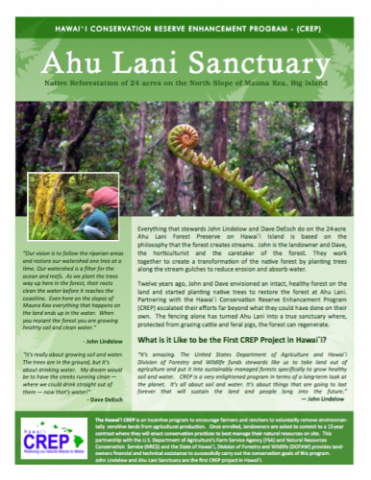
The Hamakua region of Hawaii’s Big Island becomes home to many new landowners each year. Many of these landowners are retirees, having moved to Hawaii from the mainland United States or another part of Hawaii. The resulting landscape is one of diverse perspectives and opportunities for learning. To protect this landscape, the Hawaii Conservation Reserve Enhancement Program (CREP), a partnership between Hawaii’s Division of Forestry and Wildlife (DOFAW) and the USDA’s Natural Resource Conservation Service and Farm Service Agency, provides these landowners with financial and technical assistance to enact conservation goals on their land.
After participating in a TELE workshop in Hilo, Hawaii in May 2015, Irene Sprecher and her team at DOFAW began to develop several targeted marketing approaches to landowner outreach based on a “peer to peer” model, leveraging the experiences and stories of Big Island landowners already engaged in government programs and actively managing their forests. Their goal? Educate primarily new landowners about conservation practices and available forest management programs, including Hawaii CREP, inspiring them to engage with the program and, ultimately, to write and implement management plans for their land.
Focusing on the specific priorities of landowner segments in Hamakua, Irene and her team have enhanced their outreach by developing informational reports for landowners written from the perspectives of landowners already engaged in conservation activities ranging from native forest restoration for wildlife habitat to agroforestry. DOFAW and their agency partners have interviewed landowners and created a series of reports, each based around a different landowner perspective and practice. The reports highlight each step of the project, challenges, lessons learned, and direct quotes from landowners and managers working on the property.
Building on this peer to peer outreach, the agency partners have also begun a series of workshops that take landowners out on the land to explore projects underway on a neighboring landowner’s property. With this model, local landowners have the opportunity to walk the land with their own neighbors and learn from their experiences. Professional forest managers and agency staff are always on hand to answer technical questions, but the landowners take the lead at each workshop. This model has proved both successful and empowering, inspiring Hamakua landowners to reach out to their neighbors on their own, building communities and sharing knowledge around forest conservation.
With these targeted marketing programs, and a series of follow up emails and letters to landowners who have expressed interest in forest management through any partners’ program, Irene and DOFAW are looking forward to measuring the impact of their outreach and tracking landowners’ next steps in response to reports and workshops facilitated by their peers. With this evaluation, they hope to expand the scope of their outreach to other key ecosystems on the Big Island and other islands in Hawaii.